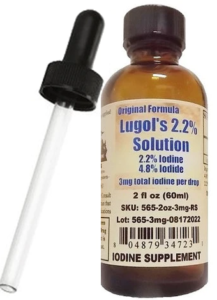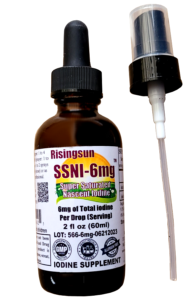Lugol’s Iodine vs Super Saturated Nascent Iodine What’s Best
Lugol’s iodine and nascent iodine were discovered at different times and under different circumstances and have different characteristics. Reviewing the differences between Lugol’s iodine and nascent iodine may help you to determine which type of iodine is best for you by taking a look at Lugol’s iodine vs super saturated nascent iodine, what’s best for you?

In 1829, a French physician named Jean Lugol developed this form of iodine. It was a transparent brown liquid containing ten parts potassium iodine, five parts iodine, and 85 parts distilled water. Lugol’s Iodine proved an effective bactericide and fungicide as well as an antiseptic for more than a century.

Nascent iodine, also referred to as atomic iodine or Atomidine, is a liquid supplement containing iodine that is meant to be taken orally. It is said to be in its monatomic state and was first developed from an Edgar Cayce formula in 1931. In his readings, Cayce mentioned the importance of using electrified and nascent iodine for easier assimilation by the body.
In some instances, some individuals prefer super-saturated nascent iodine and ionic iodine in distilled water over Lugol’s iodine for several reasons.
Top 10 Results Lugol’s vs. Nascent Iodines
1. Iodine purity:
Nascent iodine products use pure forms of iodine, such as USP grade or pharmaceutical grade iodine crystals. Lugol’s iodine contains iodide bonded to potassium (KI) as well as free iodine (I). It is less pure than USP grade iodine that is used in nascent iodine products.
2. Nascent iodine’s increased bioavailability:
In contrast to Lugol’s iodine, nascent iodine is credited as having higher bioavailability. A form of iodine known as “nascent” is considered to be more readily absorbed and usable by the body than Lugol’s iodine. As a result, advocates argue that iodine can be absorbed and used more effectively at the cellular level. Lugol’s iodine, on the other hand, is bound to the mineral salt potassium, which is slower to absorb.
In order to utilize potassium iodide supplements, such as Lugol’s iodine, your body must convert them. This conversion can make the product less absorbable and bioavailable than nascent iodine supplements.
3. Charges generated by electromagnetic fields:
As a result of the electromagnetic charge associated with nascent iodine, some believe that its bioenergetic properties are enhanced making it more efficient than Lugol’s in absorption by the body. Iodine may be more effective in promoting cellular health and functioning when it is charged with electromagnetic energy, which makes it easy for the body to absorb it.
4. Potassium Iodide (KI) is not present:
In contrast to Lugol’s iodine, super-saturated nascent iodine typically does not contain potassium iodide. For individuals with concerns or sensitivities related to KI, formulations without KI may be preferable. If you are looking for a pure iodine supplement without additional compounds, then this is especially relevant.
5. Oral deployment:
While both Lugol’s iodine and nascent iodine can be taken orally. Lugol’s can be used both orally and topically, while nascent is formulated for taking orally only.
6. Better taste and odor:
It is common for nascent iodine solutions to be advertised as having a milder taste and odor compared to Lugol’s iodine.
7. Reduced iodine content:
As a result, some super-saturated nascent iodine products may have a lower iodine concentration than Lugol’s iodine, making them more suitable for individuals who need smaller doses or who need a specific amount of iodine.
8. Sensitivities alternative:
Lugol’s iodine may cause sensitivities or adverse reactions in individuals, so super-saturated nascent iodine may be an alternative. Those with specific sensitivities may find Lugol’s iodine more suitable because certain additives or compounds aren’t present.
9. Cost difference:
If cost is a barrier, be aware that nascent iodine is usually more expensive than Lugol’s iodine, so this may be something to consider.
10. Lugol’s iodine and thyroiditis:
Lugol’s iodine’s breakdown and separation of potassium from iodide can lead to an enlarged thyroid known as thyroiditis when the body metabolizes it. Nascent iodine has no such problem.
Despite the fact that increasingly more people are preferring super-saturated nascent iodine to Lugol’s iodine for the reasons mentioned, the scientific evidence to support these claims may be limited. Before making significant changes to your iodine supplementation, it is advisable to consult your healthcare professional. They can provide guidance based on your specific health needs. Taking into account your personal health conditions, dietary needs, and medication interactions is important.